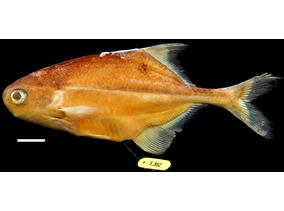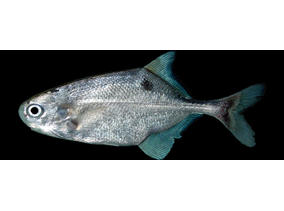Vous êtes ici
Mormyridae
Petrocephalus grandoculis Boulenger 1920
Nomenclature
-
Subfamily: PetrocephalinaeGenus: Petrocephalus
SUMMARY
Petrocephalus grandoculis is a medium–sized species within the genus Petrocephalus (maximum standard length observed = 97.8 mm). Body ovoid, body 2.5-3.1 longer than high (syntypes = 3.0–3.1) and laterally compressed. Head length 3.8–4.2 times in standard length (syntypes = 3.9–4.1). Eye quite large (2.8 ≤ head length/eye diameter ≤ 3.1, syntypes = 3.1–3.2). Snout short and round. Mouth very small (5.2 ≤ head length/head width ≤ 6.1, syntypes = 5.7–6.1), sub–terminal, opening under the anterior half of the eye. Teeth small and bicuspid, only 8–11 (syntypes = 10–11) in a single row in the upper jaw, 18–22 (syntypes = 19–20) in a single row in the lower jaw. Dorsal and anal fins originate in the posterior half of the body [standard length/pre–dorsal distance = 1.6 and standard length /pre–anal distance = 1.7]. Pre–dorsal distance slightly greater than pre–anal distance. Dorsal fin with 25–26 branched rays (syntypes = 24–26). Anal fin with 30–33 branched rays (syntypes = 30–31). Scales cover the body, except for the head. Lateral line visible and complete with 37–39 (syntypes = 38) pored scales along its length. Caudal peduncle relatively thin (2.2 ≤ caudal peduncle length/caudal peduncle diameter ≤ 3.0, syntypes = 3.0). Twelve scales around the caudal peduncle. Skin on head thick, becoming opaque with formalin fixation. The numerous Knollenorgan electroreceptors on the head are organized into two visible rosettes (Augenrosette and Nackenrosette). The third rosette, the Kehlrosette, is present but this structure is not as discernable as it is in other species (e.g., P. binotatus).
Body mostly white–silver. Dorsum slightly darker than the rest of the body. Pigmentation pattern consists of two melanin markings: (1) a distinct, but weak, round black mark below the anterior base of the dorsal fin (first to fifth rays); (2) a crescent–shaped mark at the base of the caudal fin, which does not extend onto the rayed portions of the upper and lower caudal fin lobes. No black mark is present at the base of pectoral fin. The fins themselves are translucent.






